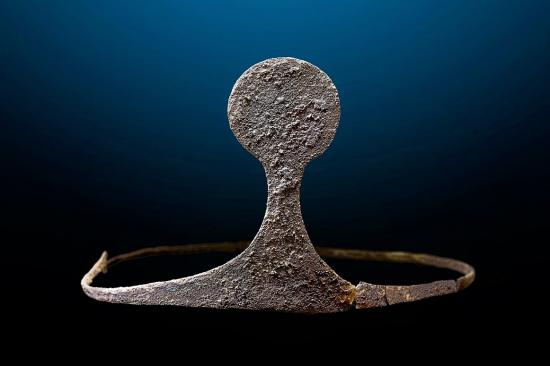Universitat Autònoma de Barcelona
Source - http://www.uab.cat/web/newsroom/news-detail/bronze-age-palace-and-grave-goods-discovered-1345668003610.html?noticiaid=1345676313107

General view of the main buildings discovered in La Almoloya (Pliego, Murcia) [Credit: Universitat Autònoma de Barcelona]
An excavation conducted in August by the researchers of the UAB’s Department of Prehistory Vicente Lull, Cristina Huete, Rafael Micó y Roberto Risch has made evident the unique archaeological wealth of La Almoloyasite, located in Pliego, Murcia. The site was the cradle of the "El Argar" civilisation which lived in the south-eastern part of the Iberian Peninsula during the Bronze Age.
La Almoloya is located on a steep plateau which dominated an extensive region. This strategic and privileged position gave way to over six centuries of occupation, from 2200 to1550 before our common era. The site was discovered in 1944 by Emeterio Cuadrado and Juan de la Cierva.
The findings indicate that La Almoloya was a primary centre of politics and wealth within the political territory of El Argar - located a few hundred kilometres to the south in Almeria - and sheds new light on the politics and gender relations in one of the first urban societies of the West.

Governing hall at La Almoloya. Archaeologists affirm that this is the first time a building specifically designed for political purposes is discovered in Western Europe [Credit: Universitat Autònoma de Barcelona]
A Palatial Building and new Argaric Style
The discoveries made by the archaeological team include an urban tissue made up of fully equipped buildings, as well as dozens of tombs, most of them including grave goods. According to archaeologists, this urban tissue, as well as the solidity and mastery of the construction techniques, are unique samples of pre-historic constructions in continental Europe.
The excavations indicate that the La Almoloya plateau, of 3,800 metres square, was densely populated and included several residential complexes of some 300 square metres, with eight to twelve rooms in each residence.
The buildings' walls were constructed with stones and argamasa, and covered with layers of mortar. Some parts contain stucco decorated with geometric and naturalistic motifs, a novelty which represents the discovery of an Argaric artistic style.
Among the discoveries made is a wide hall with high ceilings measuring some 70 square metres, with capacity for 64 people seated on the benches lining the walls. The hall includes a ceremonial fireplace and a podium of symbolic character. This unique building was used for political purposes and archaeologists consider that it must have been used to celebrate hearings or government meetings.
Archaeologists affirm that this is the first time a building specifically dedicated to governing purposes has been discovered in Western Europe, and believe that decisions were taken here which affected many of the region's other communities.
The hall and adjoining rooms make up a large building which the archaeologists have classified as a palace. They highlight the fact that only the most important of Oriental civilisations had similar constructions during the Bronze Age, with comparable structures and functions.
Several items were recovered from the interior of the buildings, including objects made with metals, stones, bones, fabrics and ceramics; all in exceptional states of conservation.
A Princely Tomb with Objects of Great Value

Interior of the royal tomb with the skeletons and grave goods [Credit: Universitat Autònoma de Barcelona]
Of the fifty tombs excavated from under the La Almoloya buildings, one stands out in particular. Located in a privileged area, next to the main wall of the hall, the tomb reveals the remains of a man and woman buried with their bodies in a flexed position and accompanied by some thirty objects containing precious metals and semi-precious stones.

Detail of the jewels, with the golden and silver ear dilators [Credit: Universitat Autònoma de Barcelona]
One of the most outstanding pieces is a silver diadem which encircled the skull of the woman. The silver diadem is of great scientific and patrimonial value, since the only other four diadems known to have existed were all discovered 130 years ago at the site of El Algar in Almeria, but none of them remain today in Spain.

Silver diadem discovered in the royal tomb. It is the only one from that era conserved in Spain [Credit: Universitat Autònoma de Barcelona]
Four ear dilators, which are unusual objects for the Bronze Age, were also discovered; two are made of solid gold and two of silver.

Ear dilator [Credit: Universitat Autònoma de Barcelona]
PART.2